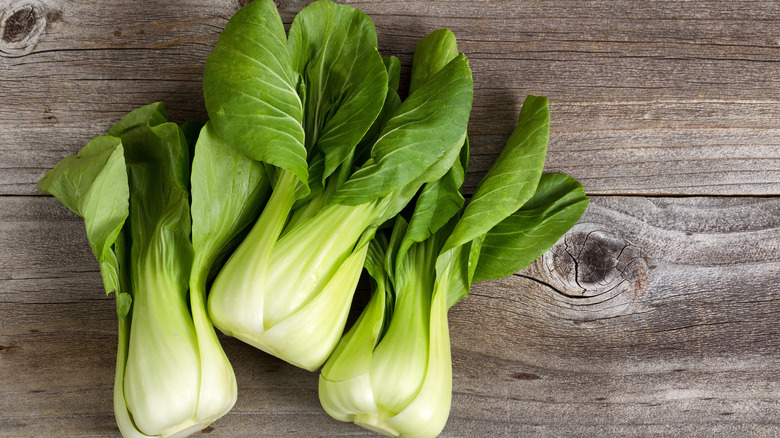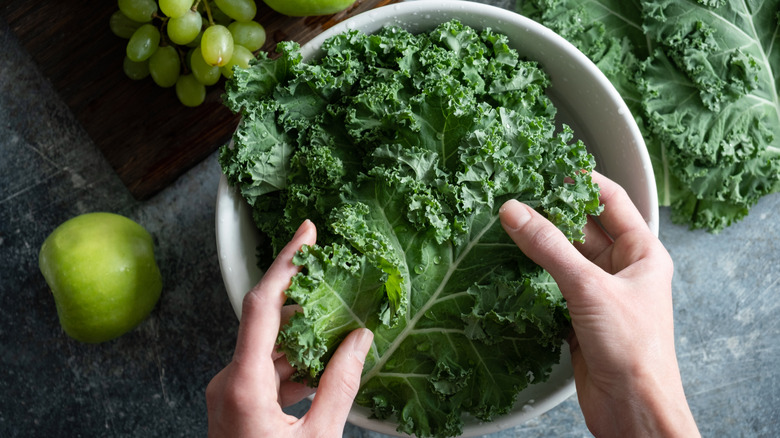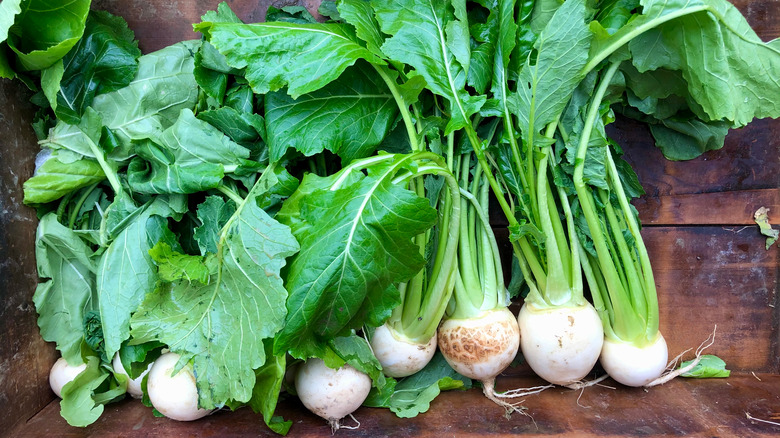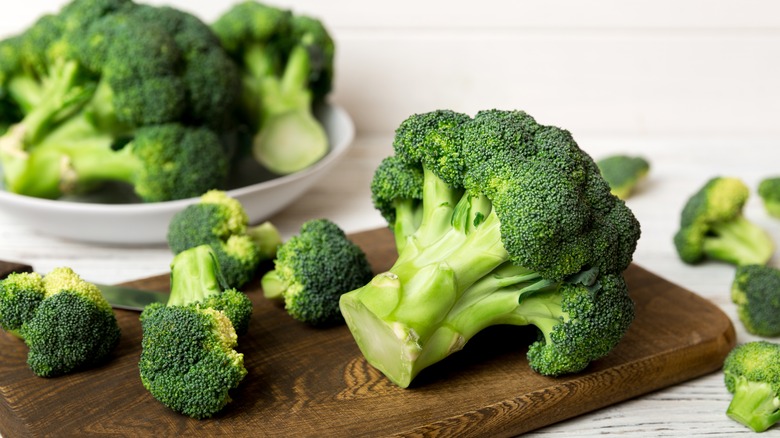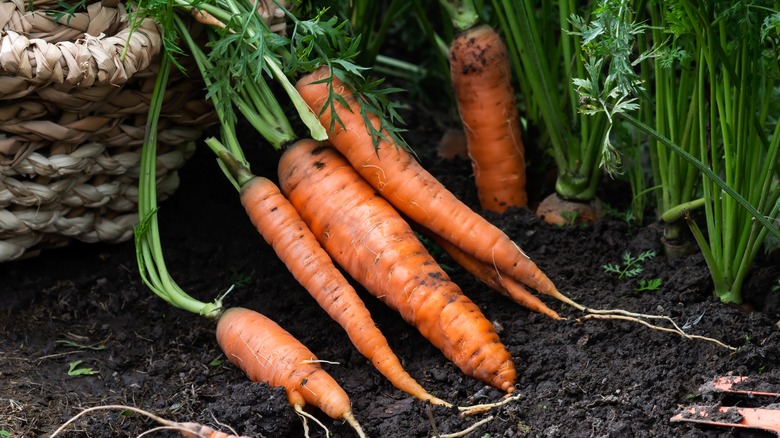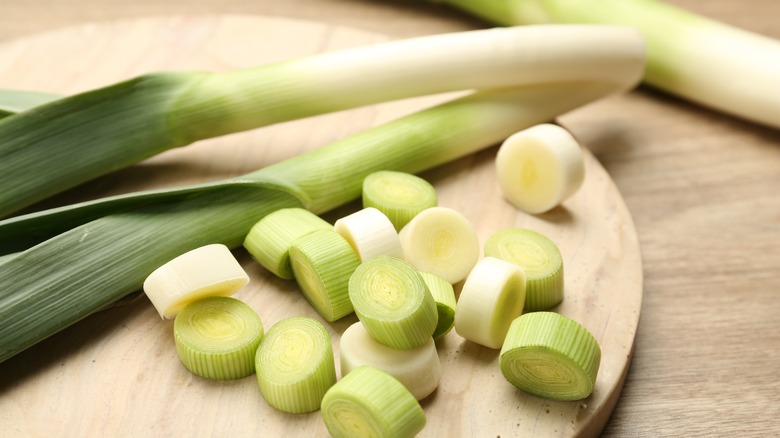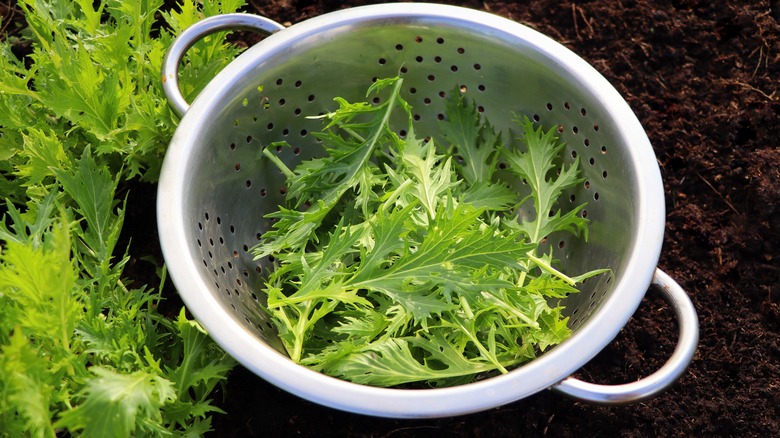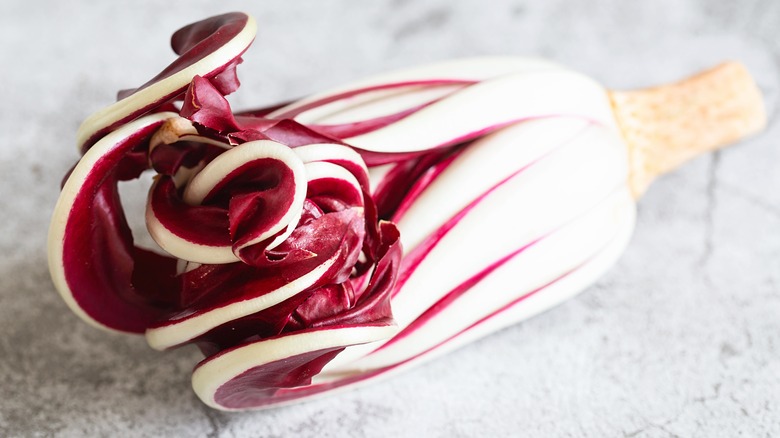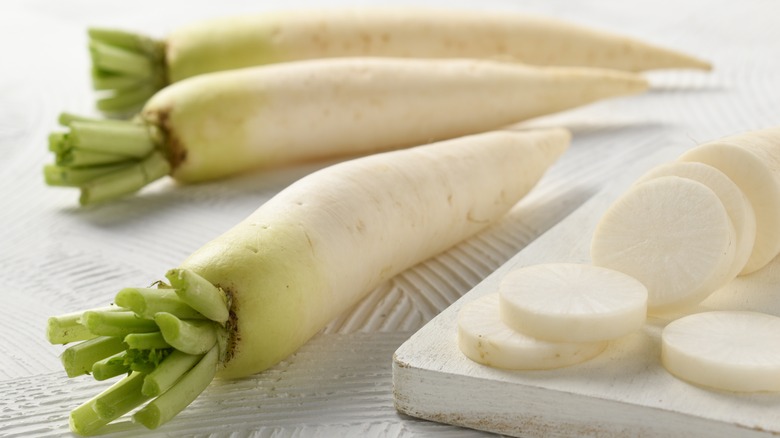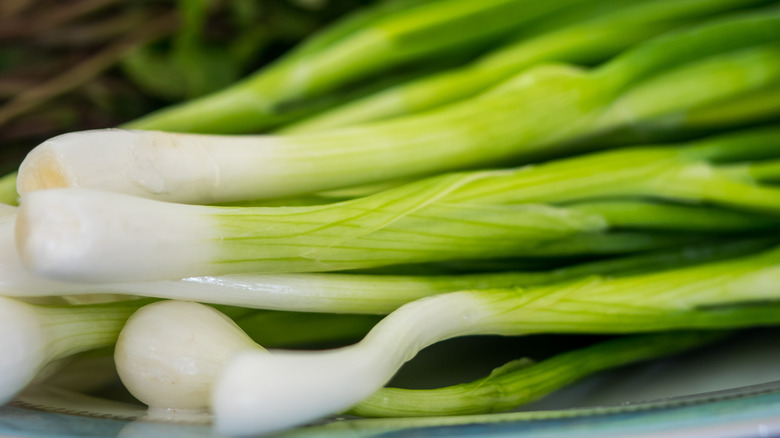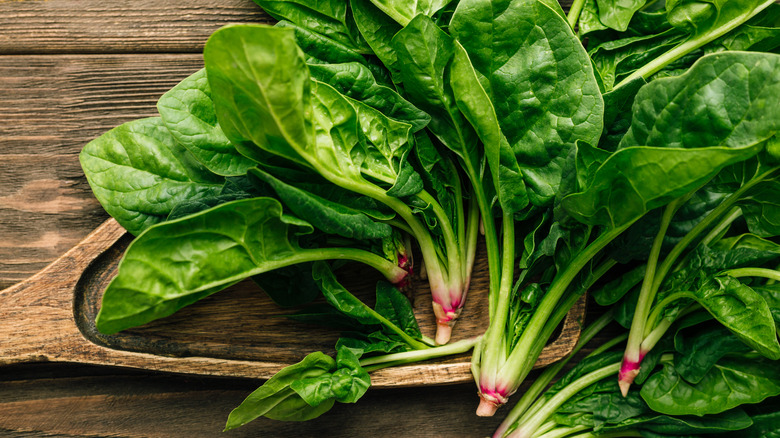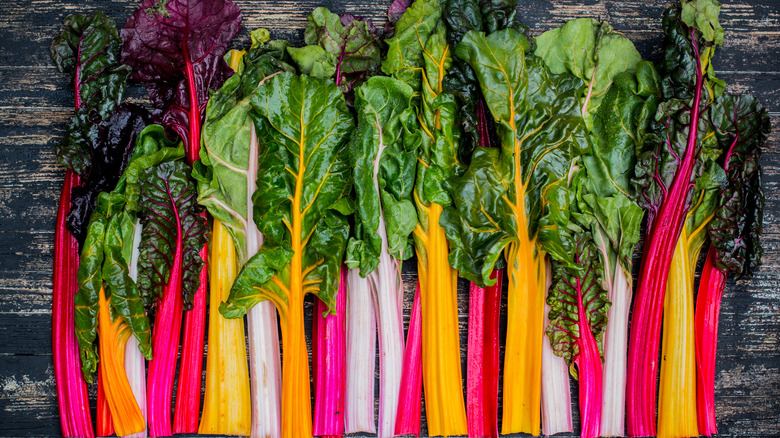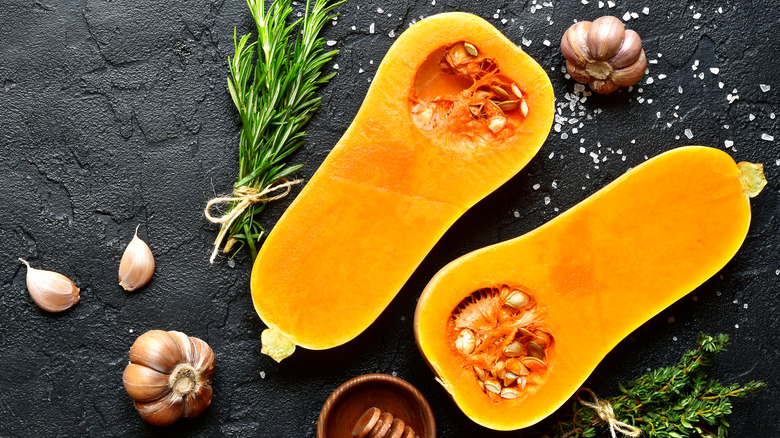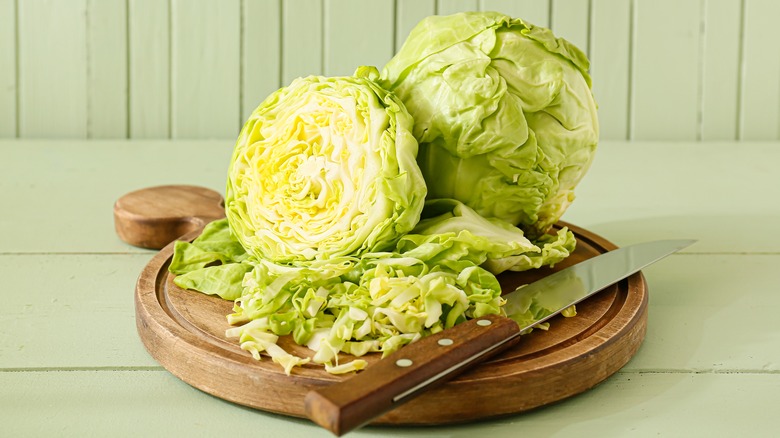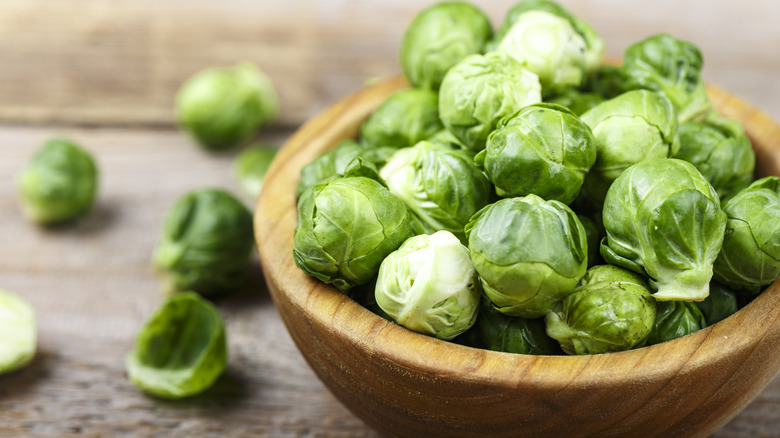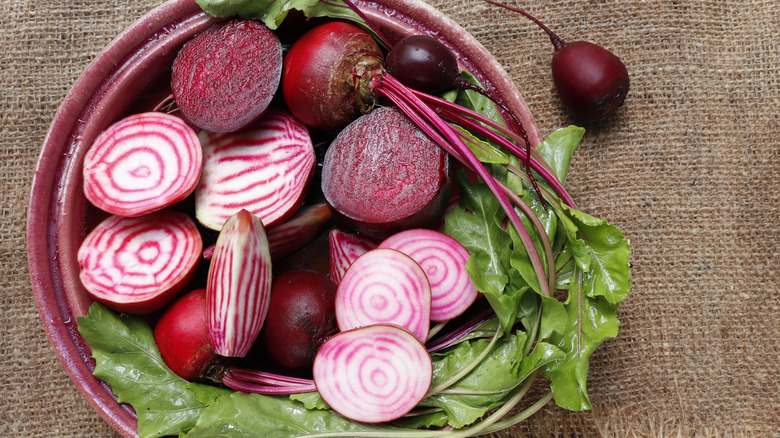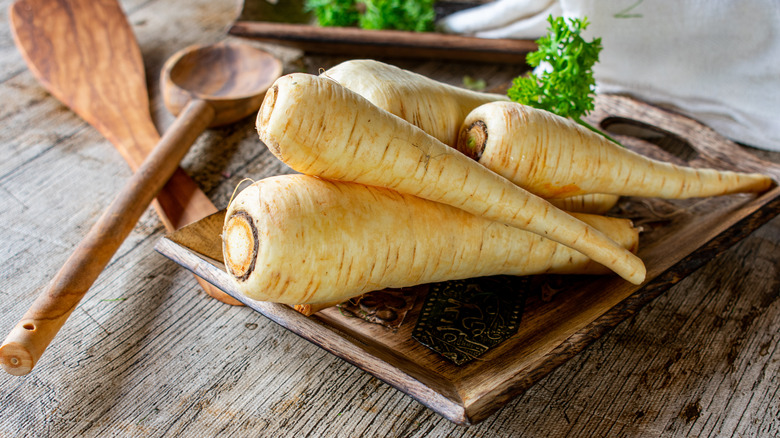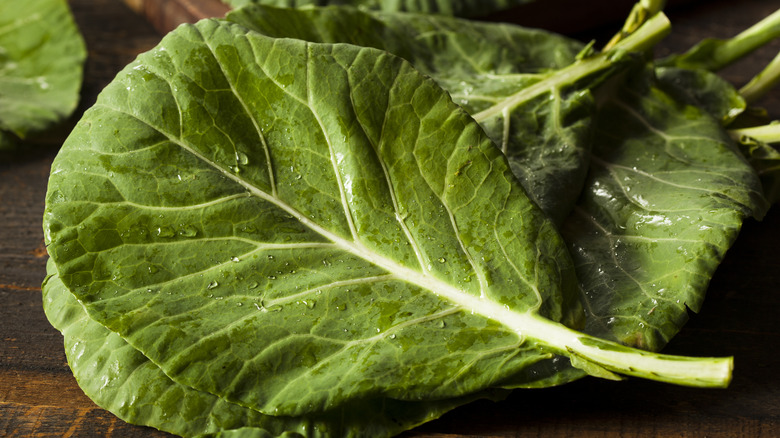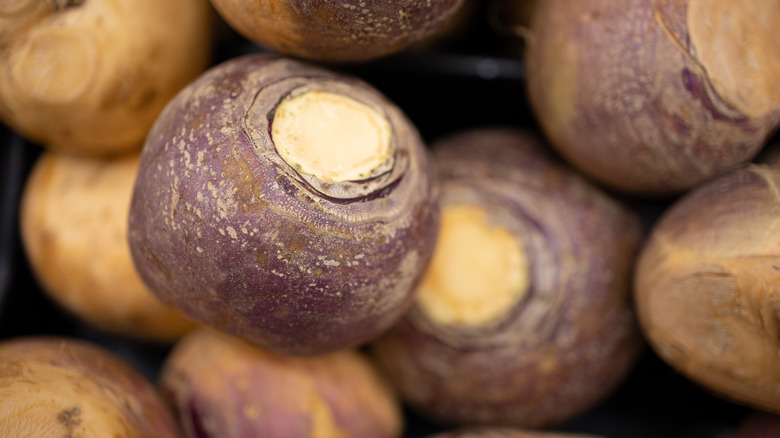19 Winter Vegetables And How To Cook With Them
We may receive a commission on purchases made from links.
When you see winter vegetables at the grocery store or farmer's market, it's normal to hesitate to buy them when you don't know how to cook with them. But once you become more familiar with them, you're more likely to stock up and actually cook with them rather than let them rot in the fridge. After all, winter vegetables are brimming with nutrition and flavor.
We aim to help you be more confident with your winter produce purchases, offering more information about what the foods taste like, what their nutritional content is, how to choose them, and how to cook with them. You may decide to throw kale into everything for added nutrition and choose leeks or scallions instead of onions for their delicate flavor. And why not try something new like mizuna? True, the lion's share of winter vegetables have very strong flavors -– particularly those in the Brassica genus, like Brussels sprouts and collard greens. However, every vegetable has the potential for greatness when you cook it with the proper method and pair it with the best ingredients.
Bok choy
Bok choy comes in a loose bunch with thick, white stalks terminating in bright green leaves. When you cook bok choy, it becomes soft, creamy, sweet, and almost meat-like, with an earthy taste reminiscent of chard or spinach (via Cook's Illustrated). However, it's important not to overcook it. Bok choy contains a significant amount of vitamins A, C, and K, along with calcium, phosphorus, potassium, zinc, manganese, selenium, and folate (via Healthline).
Cook's Illustrated says you'll want to choose bunches with white stalks and bright green, flawless leaves. Bunches with smaller heads have soft rather than woody stalks. You'll want to start cooking the stalks before adding the leaves to your dish since stalks take longer. Because bok choy is delicate, it's good for steaming, sautéeing, stir-frying, and grilling (via MasterClass). It also tastes great in Asian-inspired dishes such as chicken chop suey or stir-fried udon noodles.
Kale
Kale leaves have a strong and earthy flavor (via Foods Guy). They're nutrient-dense and chock full of manganese, calcium, copper, potassium, magnesium, and vitamin B6. They also provide 134% of the daily recommended value of vitamin C, 206% of the daily value of vitamin A, and a whopping 684% of the daily value of vitamin K (via Healthline).
Whole Foods says that the best kale is dark green without discoloration. You'll want to avoid choosing older, tougher kale since it's less tasty. Before cooking with kale, you should strip the leaves from the stem (via America's Test Kitchen). The best ways to cook with kale are sautéing and steaming. You can also bake kale into chips or add it to soups. Many recipes use kale as a secret ingredient to increase nutrient content. You can add it to everything from cakes and cookies to oatmeal and granola. It also works well in Italian foods like lasagna and pesto. Several studies have shown that cooking reduces kale's nutritional content, so consider consuming it raw in a salad or a green smoothie. If you prefer cooked kale, steaming allows it to retain the most nutrients (via Healthline).
Turnips
With turnips, both the roots and leaves are edible. Turnip roots contain a significant amount of vitamin C, folate, phosphorus, and calcium. Meanwhile, turnip greens are full of vitamins C, provitamin A, folate, and calcium. But this vegetable's real claim to fame is its 115% of the daily recommended value of vitamin K (via Healthline).
Raw, young turnip roots are sweet, while older turnip roots have a more peppy taste like raw cabbage. When cooked, turnip roots become creamy with an earthy, nutty flavor (via Flavorful Home). When choosing turnip roots, look for heavy, firm, and unblemished ones that are small. Turnip roots also require peeling before cooking (via Healthy Family Project). They are good sautéed, grilled, or roasted (via Purdue University Extension).
When choosing turnip greens, Purdue University Extension says to look for green leaves that aren't limp or blemished. Turnip greens' taste ranges between mild and sweet to peppery and pungent. The best way to prepare them is by steaming, sautéing, or stewing (via Harvest Table). If you choose smaller leaves and cook them less, they will be more bitter. Some people swear by adding sugar, Bragg Liquid Aminos, or a potato while cooking cuts the bitterness. Replenishing the cooking water with fresh water several times while boiling also helps (via Soul Food and Southern Cooking).
Broccoli
Both broccoli florets and stalks are edible, and the cooked version has a milder flavor than many cruciferous winter vegetables. This tasty vegetable is high in fiber and contains potassium, manganese, iron, folate, and vitamin K1. Broccoli also provides nearly 70% of the recommended daily value of vitamin C (via Healthline).
The best broccoli has firm stalks and dark green florets. You'll want to avoid broccoli with yellowing buds or woody stems. Be sure to peel the tough outer layer of the stalks before cooking with them for the best results. The best way to cook broccoli is by steaming, boiling, or stir-frying just until it's tender. Just be sure not to overcook your broccoli lest it develop a strong flavor and become mushy (via Kraft Heinz). Broccoli is great alone, barely needing any seasoning. However, there are plenty of interesting ways to cook with broccoli, including crispy roasted parmesan broccoli, beef and broccoli stir fry, broccoli cheddar soup, and broccoli casserole.
Carrots
For most of us, carrots aren't a new vegetable. However, it can be disappointing to end up with bitter rather than sweet carrots. Food writer Karen Fernau told AZCentral the best carrots are usually "firm, plump carrots without rootlets (little strings on the bottom). The best carrots are small, bright orange, and smooth, without cracks." She says you should choose carrot bunches that still have their leaves and avoid dried or yellowing ones. According to Healthline, carrots are extremely healthy and an excellent source of biotin, potassium, and vitamins A, K1, and B6.
Unless you purchase pre-peeled baby carrots, you'll need to remove the ends of the carrot and use a vegetable peeler to remove the bitter outer layer. The most common ways to cook carrots are boiling, steaming, and roasting (via Better Homes and Gardens). Adding a honey glaze, roasting with parmesan, or turning them into a creamy roasted carrot soup are excellent ways to bring more flavor to this standard vegetable.
Leeks
If you've never tried leeks, you'll likely be surprised at their sweet, mild flavor. While leeks are in the allium family with onions, they're closer in taste to the more mild shallots (via MasterClass). Leeks contain iron, calcium, vitamin C, and vitamin K (via WebMD).
According to MasterClass, you'll want to choose leeks with pristine white bases and dark green leaves that aren't wilting. The edible parts of leeks are the fat, white bases and the light green middle. People don't generally eat the dark green parts because they are fibrous and tough. It's necessary to soak leaks for half an hour to help remove any residual dirt. Then, after you chop them, it's best to let them sit for at least five minutes. Leeks are great roasted or sautéed. They're also common flavoring components in soups like this chunky potato leek soup and Instant Pot potato leek soup.
Mizuna (Japanese mustard greens)
If you haven't seen mizuna among winter market vegetables, it may be because it's labeled as Japanese mustard greens, spider mustard, kyona, or water greens. You'll want to choose mizuna with bright green leaves that aren't yellow, dry, or limp (via Instacart). Mizuna tastes slightly bitter, peppery, and tangy, like a mix of spinach, mustard greens, and sorrel. It's one of the best-tasting mustard greens, and you can even eat the flowers (via Los Angeles Times). This low-calorie vegetable contains iron, calcium, and vitamin C. It also contains over 100% of the daily recommended value of vitamin K and 222% of the daily value of vitamin A (via Healthline).
Preparing Japanese mustard greens involves washing, stripping the leaves off the stems, and chopping the greens. Instacart says mizuna goes well in salads as well as in pasta dishes, pizza, and casseroles. You can also add it to risotto, stir-fries, and soups. However, the easiest way is to sauté leaves in garlic and olive oil (via Sand n' Straw Community Farm).
Radicchio
Radicchio is a beautiful winter vegetable that is easy to overlook for lack of familiarity. It has a bright, slightly bitter flavor and tastes great raw or cooked. While radicchios look a little like red cabbage, they're actually in the chicory family, along with endive and dandelions (via Whistling Train Farm). This vegetable contains iron, zinc, copper, phosphorus, potassium, vitamin C, and vitamin B6. It also provides 170% of the daily recommended value of vitamin K (via Healthline).
Healthline recommends choosing unblemished radicchios with bold coloring, prominent white ribbing, and no soft spots. Preparation involves trimming the outer leaves and washing the vegetable. To tame its bitter flavor, it's best in dishes with sweet or acidic components. Radicchio is a traditional ingredient in Mediterranean and Italian dishes like Panzanella. While you can eat it raw in salads, it's also excellent grilled or added to soups, risotto, pasta, and pizza.
Winter radishes
Winter radishes come in black, white, and green colors. Black radishes are the most pungent, Chinese and watermelon radishes have a milder flavor, and Daikons are light and refreshing (via University of Illinois Extension). Radishes contain a number of minerals, including potassium, folate, riboflavin, niacin, calcium, magnesium, zinc, phosphorus, copper, and manganese. They also provide vitamin B6 and vitamin K (via Healthline).
University of Illinois Extension says all radish leaves are edible. Daikon leaves can be stirred into rice and soups. You'll want to start by julienning the leaves and letting them sit in salt for an hour before cooking them. "Chopped" judge Alex Guarnaschelli says radish greens are also great in salads and stir-fries (via Twitter).
Many people consume winter radish roots raw or preserved, but larger Chinese and Japanese variations are excellent for cooking. Start out by cutting off the root and stem end and then peeling. You can substitute larger radishes in any dish that calls for turnip roots. Winter radishes are good in salads and slaw. They can also be sautéed, roasted, and braised (via Milwaukee Journal Sentinel).
Scallions
Scallions and green onions are basically the same thing — only scallions are harvested when they're younger and haven't developed a plump bulb yet. However, the mild onion taste for both is the same. No matter when you pick or buy your green onions, the micronutrient content is the same. They contain folate and vitamin C, along with an impressive 173% of the recommended daily intake of vitamin K (via Healthline).
Start preparing scallions by removing the stringy root and any wilted tops. You can then cut them crosswise or lengthwise (via Clean Green Simple). According to Healthline, you can use scallions in the same dishes that call for green onions or spring onions. They're popular in salads and as a last-minute garnish, and their mild flavor elevates soups and stews. Mashed says they're popular in Asian-inspired dishes like ramen and stir-fries, cheesy dishes, baked goods, noodle dishes, and scallion pancakes.
Spinach
Raw spinach has a mild and sweet flavor, but when you cook this winter vegetable, it tastes stronger and more acidic (via Blogchef). While it's easy to hide spinach in dishes, it does give them a slightly vegetal flavor. Spinach contains folic acid, iron, calcium, potassium, and magnesium, along with vitamins A, C, K1, B6, B9, and E (via Healthline).
Look for spinach leaves that are crisp, dark green, and not yellowing. You'll want to wash your spinach to remove any excess grit. There are lots of ways to cook spinach, including sautéing, boiling, blanching, steaming, or eating raw in salads or smoothies (via Healthy Family Project). You can also put spinach in soups and sandwiches. Some spinach recipes to try include garlic-sautéed spinach and spinach quiche. Spinach also pairs well with dairy, so you'll enjoy it in spinach artichoke dip, in creamed spinach, or on top of pizza.
Swiss chard
Swiss chard (also known as silverbeet) is in the Chenopodiaceae family of vegetables that also includes beets and spinach (via University of Florida Institute of Food and Agricultural Sciences). While the flavor of Swiss chard is bitter when raw, it becomes milder and sweeter like spinach when cooked (via MasterClass). According to Colorado State University Food Source Information, its stems can come in a variety of colors: pink, red, yellow, and purple. Swiss chard is nutritious, containing magnesium, copper, manganese, iron, potassium, and calcium, along with vitamins A, C, and E. It also contains 477% of the daily recommended value of vitamin K (via Healthline).
To prepare Swiss chard for cooking, you remove the stalks from the leaves and then cut the stalks crosswise and the leaves into ribbons (via Cutco). MasterClass says Swiss chard is excellent in salads and sautéed or braised in soup. Creamed Swiss chard is similar to its spinach counterpart. In fact, cooks often use spinach and Swiss chard in similar ways because of their similar tastes.
Winter squash
Winter squash includes everything from butternut squash and spaghetti squash to pie pumpkins and kabocha squash. They vary in flavor and nutrition. Nearly all are high in vitamin C with acorn squash providing lots of vitamin B and magnesium, pumpkins providing lots of beta carotene, and kabocha providing provitamin A (via Healthline). Winter squash is also a source of potassium (via Consumer Reports).
Because there are so many winter squashes from which to choose, there are a lot of ways to cook them. Baking, boiling, and steaming are the most common choices. You'll need to peel the squash first and remove the seeds unless you are baking it. If baking, you'll need to pierce the skin before baking and remove the seeds after baking (via Michigan State University Extension). Winter squash soup and butternut squash pasta are nice choices. You can also try mashing them as you would potatoes.
Winter cabbage
The difference between summer and winter cabbage is that summer ones tend to have looser leaves, while winter ones are more compact. However, they pretty much taste the same. Being in the Brassica family, cabbage can have a strong smell and flavor when cooked because of activated sulfur compounds (via Canadian Food Focus). Cabbage contains folate, manganese, potassium, calcium, magnesium, and vitamin B6. It also provides 54% of the recommended daily intake of vitamin C and 85% of the recommended amount of vitamin K (via Healthline).
Canadian Food Focus says to look for firm, heavy cabbage heads with crisp, blemish-free leaves and no wilting. If you avoid aluminum pans and add something acidic (like vinegar or lemon juice), you can minimize the sulfur smell when cooking. Healthline declares cabbage good raw, cooked, or fermented (like sauerkraut or kimchi). You can eat it raw in salad and slaw or cooked in stews. You can also enjoy cabbage rolls, perogies, and soups.
Brussels sprouts
Brussels sprouts have a strong taste similar to cabbage, so liking them is often about learning to master them so they have more of a sweet and nutty flavor (via Insanely Good Recipes). Healthline says they contain folate, along with 53% of the daily value of vitamin C and 91% of the daily value of vitamin K.
Mashed says to look for tight, green buds. Purple or white on the bud is okay, but you'll want to avoid yellowing ones. To prepare them, remove the bottom base and the first layer of leaves. As cruciferous vegetables, they're high in sulfur, which produces an egg-like smell, especially when overcooked. So cook only until they're tender when pierced with a fork but never gray. Healthline suggests roasting, boiling, or sautéing them. They're also fitting additions to pasta, frittatas, and stir-fries. To make Brussels sprouts more appealing, you can cook them with bacon. You can also shred them raw for slaw or salad (via Southern Living).
Beets
Beets are sweet but can have a dirt-like flavor if not prepared properly. While most are deep red or bright purple, it's also possible to find yellow or white beets (via Flavorful Home). Beets provide folate, manganese, potassium, iron, and vitamin C (via Healthline). If you're trying beets for the first time, there's no need to be alarmed if it turns your urine and feces reddish. We promise that you're not dying (via AllRecipes).
Per Flavorful Home, beet leaves and roots are edible both cooked and raw. You can sauté, steam, or boil the leaves or add them to smoothies, pasta, or omelets. Meanwhile, beetroots are great steamed, roasted, or pickled. Roasting them helps to bring out their sweetness. Adding vinegar can also help make them taste less like dirt. Beets may sometimes find their way into desserts like chocolate cake or even red velvet cake for coloring.
Parsnips
Not only do parsnips look like a white version of carrots, but they also come from the same Apiaceae family. Spices like anise and coriander also belong to this family (via Britannica). So, it's not surprising that parsnips have a spicy undercurrent with the sweetness of carrots (via MyRecipes). Parsnips contain folate, magnesium, thiamine, phosphorus, and zinc, along with vitamins C, K, E, and B6 (via Healthline).
When choosing parsnips, look for ones that are firm and without discoloration. Any attached tops should be green, and you should avoid those with hairy roots. Parsnips have tough skin and a woody inner core that you may want to remove before slicing and cooking (via Los Angeles Times). According to Healthline, cooking methods for parsnips include steaming, roasting, baking, grilling, frying, or pureeing. They make great additions to soups, casseroles, and gratins or as substitutions for other root veggies like yams.
Collard greens
Because collard greens have a bitter flavor, strong smell, and slimy texture, they can be an acquired taste if not cooked properly. They're from the same family as kale and have a comparable flavor. They contain calcium, folate, magnesium, potassium, phosphorus, vitamin C, and vitamin A, along with 128% of the daily value of vitamin K (via Healthline).
Collard leaves should be green and blemish-free. Before cooking, it's important to submerge them in water to remove any grit. You can cut young, tender collard leaves for salads. Larger greens are better for roasting, sautéing, or braising after removing the woody stems (via Vegetarian Times). To ensure your collard greens aren't bitter, you'll need to cook them for at least an hour or two. It's common to add salt and lemon juice or vinegar to combat bitterness (via LeafTV). Many collard greens recipes also call for meats like ham hocks or turkey to enhance the flavor.
Rutabagas
Rutabagas (also called swedes or Swedish turnips) are cruciferous root vegetables that look and taste a lot like a turnip root, only they have a more mellow, buttery, and sweet flavor that's also savory and slightly bitter (via The Mom 100). Rutabagas contain iron, magnesium, potassium, vitamin E, and calcium, along with 162% of the daily value of vitamin C (via WebMD).
Rutabagas should be heavy, hard, and sprout-free; ugly crevices at the top are normal. To prepare them, you should trim the ends and peel off the skin. You can grate them and use them in slaws or salads. Roasting is considered the best way to bring out their natural sweetness. You can also try stir-frying, boiling, and pureeing rutabagas (via Vegetarian Times). WebMD suggests preparing rutabaga fries or adding them to soup or veggie casseroles. Basically, you can use them as you would any other root veggie.

